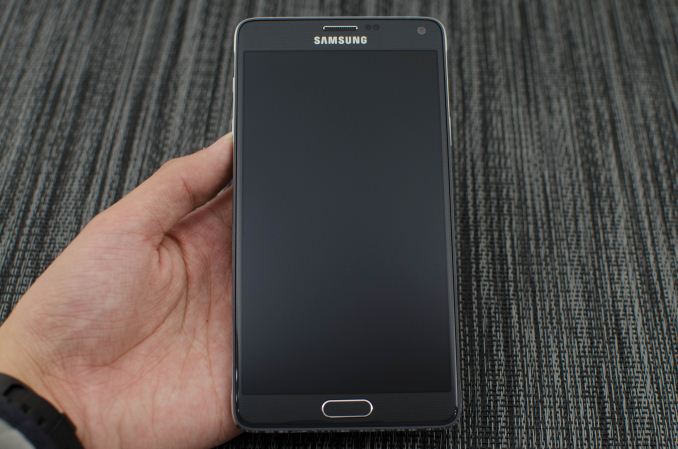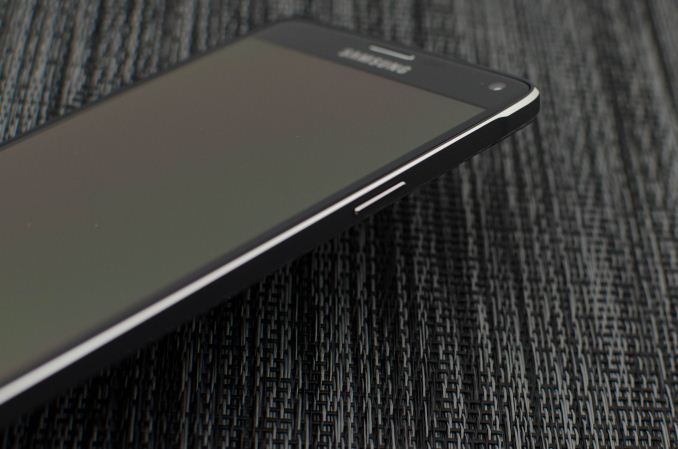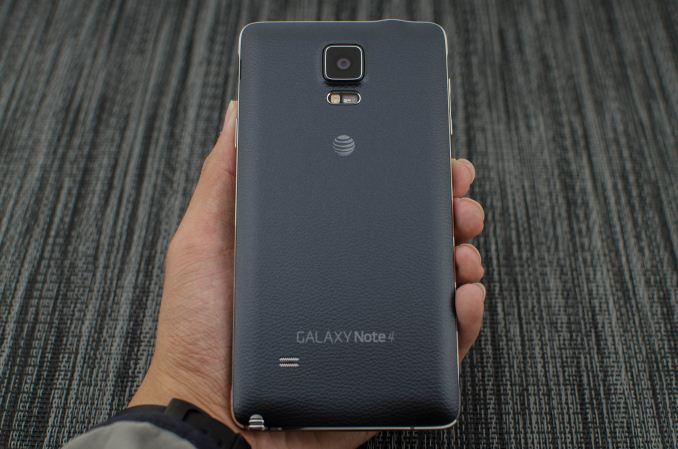The Samsung Galaxy Note 4 Review
by Joshua Ho on October 15, 2014 9:00 AM EST- Posted in
- Smartphones
- Samsung
- Android
- Mobile
- Galaxy Note 4

At this point, the Galaxy Note line needs little introduction. After all, the Galaxy Note is Samsung’s biggest success in mobile. While Apple redefined the smartphone and tablet segment, Samsung defined the phablet segment. Despite widespread skepticism, the original Galaxy Note was a massive success. Combined with the Galaxy S2, 2011 was a watershed year for Samsung as they leapfrogged other Android OEMs. Since then, we’ve seen continuous improvement from year to year with each Galaxy Note. While there were competitors, Samsung managed to hold on to their first-mover advantage for multiple generations. However, with the release of Apple’s iPhone 6 Plus we see one of the first significant threats to Samsung’s dominance of this segment.
The Galaxy Note 4 is Samsung’s latest iteration of the Galaxy Note phablet, and on the surface Samsung has put their best foot forward. With the highest bin of Qualcomm’s Snapdragon 805 or Exynos 5433, the latest generation AMOLED display, a 16MP camera with OIS, and a new design, the Galaxy Note 4 encompasses some of the best hardware that Samsung can deliver. I won’t spend too much time here, but the spec sheet below should cover most of the key points.
| Samsung Galaxy Note 3 | Samsung Galaxy Note 4 | |
| SoC | 2.26 GHz Snapdragon 800 | 2.7 GHz Snapdragon 805 |
| RAM/NAND | 3 GB LPDDR3, 32/64GB NAND + microSD | 3GB LPDDR3, 32GB NAND + microSD |
| Display | 5.7” 1080p Super AMOLED | 5.7” 1440p Super AMOLED |
| Network | 2G / 3G / 4G LTE (Qualcomm MDM9x25 IP block UE Category 4 LTE) | 2G / 3G / 4G LTE (Qualcomm MDM9x35 UE Category 6 LTE) |
| Dimensions | 151.2 x 79.2 x 8.3mm, 168 grams | 153.5 x 78.6 x 8.5 mm, 176 grams |
| Camera | 13MP Rear Facing, 1/3.06" CMOS size (Sony IMX135), 2.1MP FFC | 16MP Rear Facing w/ OIS, 1/2.6" CMOS size (Sony IMX240), F/2.0, 3.7MP FFC w/ F/1.9 aperture |
| Battery | 3200 mAh, 3.8V, 12.1 Whr | 3220 mAh, 3.85V, 12.397 Whr |
| OS | Android 4.4.2 with TouchWiz UX | Android 4.4.4 with TouchWiz UX |
| Connectivity | 802.11a/b/g/n/ac + BT 4.0, USB3.0, GPS/GNSS, MHL, DLNA, NFC | 802.11a/b/g/n/ac + BT 4.1, USB2.0, GPS/GNSS, MHL, DLNA, NFC |
| SIM Size | MicroSIM | MicroSIM |
While all of these things are easily discovered, the most immediate impressions always come from the design of the phone. In this respect, Samsung has done a surprisingly good job. On the front of the phone, we see a relatively standard design for Samsung. This entails a pattern on underneath the glass, which appears to be a bit shimmery in nature, along with dark black pinstripes. This causes a noticeable pattern in the capacitive buttons when lit, as with the LED notification light. There’s the standard earpiece and Samsung logo on top of the display, and a home button on the bottom, which serves as a fingerprint scanner as well. This home button is noticeably clicky in nature, and feels much better than the Galaxy Note 3’s home button.
On the sides, we see a similar level of improvement. The volume rocker, which is on the left side, and power button, which is on the right side, feel fantastic in comparison to most phones, and is quite close to the iPhone 6 and 6 Plus in feel. Unlike most Galaxy smartphones, we see an aluminum frame that runs all along the side of the phone, which also has a chamfered edge to eliminate sharp edges. In this area, Samsung has made serious strides as the frame really helps to make for a better in-hand feel that far exceeds what we saw with the Galaxy Note 3 or even the Galaxy S5. Along the top of the frame are cutouts for the 3.5mm headphone jack and IR port which enables TV remote functionality. Along the bottom of the frame, we see the microUSB 2.0 port. While this is technically a regression from the microUSB 3.0 port in speed and power delivery, I suspect compatibility issues and the ungainly design of the microUSB 3.0 standard justified a move back, at least until USB Type-C is ready for shipping devices.
On the back of the phone, we see some more changes. Instead of the downward-firing speakers of the Galaxy Note 3, we see that the speaker has been moved to the back of the phone. The design of the back cover is more an evolution of the Note 3’s back cover than the Galaxy S5’s, which has a noticeable faux leather pattern although the feel is closer to soft touch plastic. There’s also no stitching to try and make it seem more like leather. Instead, at the edges it seems to meet with the metal frame. A similar level of fit and finish is seen around the LED flash module, which is now flush with the back cover instead of sunk into the phone as with the Galaxy S5.
Overall, the design of the Galaxy Note 4 is massively improved. While it isn’t quite as amazing as the rounded design of the iPhone 6 and 6 Plus, it’s one of the best designs I’ve seen for a phone with a removable back cover. The only complaint I have is that Samsung should use a flat black pattern under the glass to accentuate the high contrast of the AMOLED display, but this is quite minor in nature.












195 Comments
View All Comments
JoshHo - Monday, October 27, 2014 - link
As noted in the review, the Note 4 doesn't use PDAF for continuous AF so that number isn't representative of the total "AF speed" as there's significant lag between recognizing that a scene is out of focus and the start of the focus run.Drumsticks - Wednesday, October 15, 2014 - link
It really amazes me (and is a testament to their engineers) that the A8 seems to deliver near twice the IPC/per clock performance as Krait.Also: good review in general! I think phablets are too big for me, but I like keeping up with where the market likes to go.
Calista - Wednesday, October 15, 2014 - link
Fully agree, the Apple A-series are amazing. Half the frequency, half the core count, one third the memory and still the fastest SOC more often than not while still being very frugal.danbob999 - Wednesday, October 15, 2014 - link
CPU benchmarks are not designed to test the benefit of having more RAM. One could design a benchmark using 2GB RAM. The iPhone would be slower than a Galaxy S3 because it would be swapping (or even failing).Javascript benchmarks test the browser more than the CPU. That's why the iPhone 5s still performs well in these benchmarks even tough it has a very slow CPU with no ARMv8.
mudman - Wednesday, October 15, 2014 - link
Wikipedia states that the a7 in iPhone 5s is based on armv8-a.kokono - Wednesday, October 15, 2014 - link
Does this mean iPhone6+ lags when compared to the new Galaxy?melgross - Wednesday, October 15, 2014 - link
Android needs more RAM to begin with. It's not a useful comparison.tipoo - Wednesday, October 15, 2014 - link
That's true, but not to the point of making 1GB on iOS moot vs 2-3GB Android phones. It definitely swaps apps out of memory more.KPOM - Wednesday, October 15, 2014 - link
How many phone apps really use more than 1gb right now? The iPad Air 2 will have 2 GB and my guess is that the iPhone 6s will too. But for now 1GB is fine.akdj - Thursday, October 30, 2014 - link
You're entirely TOO WRONG!Lol, what crap. I've got a Note 3, specifically for my business. The 5s as my personal, daily driver. I love em both for different reasons. Especially with what we do, the stylus on the Note for when we're doing it ...& collecting the pay for it with our clients using the SPen to sign their credit card receipt.
Other than that...nope. Nothing is 'better' on the S3, 4, 5 or Note 3 than the iPhone 5s. Display preferences aside, as an owner of both, for over a year can attest to their performance. It's ridicukius realily. My Note, again being a business line doesn't have a whole lot of apps other than productivity, a couple of 'creative' types and some excellent games to kill time on sites.
Any and EVERY app in 'parity' (available on both platforms) overwhelmingly plays more fluently on the iPhone. Productivity, cloud access and any type of 'creative' apps are abound, and they're excellent ...well optimized to a single, specific type ID hardware
It's amazing to me, in a stock cold boot of a Note 3 (I've reset a couple times), it's ALREADY using 19-2.1GB of RAM! The OEM and carrier crap is a silly joke
Apps come to iOS first. Are optimized for a single platform (& able to be played for years, fluently and with updates!). Crazy, a ⅓ the RAM, twice the processors at twice the clock speed is definitely the more 'usable' system. Customizing aside, I enjoy my home screen but for seconds ...it's the apps, their design UI and ability to 'run with reliability'. That's where iOS Smokes iOS. Secondarily, it's for a vertical & horizontal system, ala OS X.
Android has Chrome
The SPIII is a nice piece. If Windows gets ohine's figures out, Samsung's screwed.
Oh, sorry. They already are!
Then there's the tablets. Windows, again ..the SPIII is special
The Air2, incredible.
There's NOT a comparable tablet running Android. Nor will Chromebooks become anything other than a home appliance.
Sorry. You certainty don't understand RAM.